[INTERVIEW]
Dariusz Kaleta: Everything is our heritage, and art belongs to all humanity.
- February 21, 2022
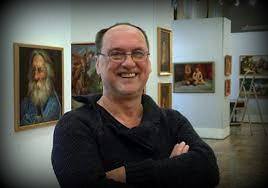
Here is our guest: the manager of the Contemporary Art Gallery in Kołobrzeg, who deals with easel painting, in which the history of Poland and Sarmatia is realistically reflected, as if in a mirror. In a word: the master of the brush - Dariusz Kaleta.
I'm glad you think so highly of me.
Considering this presentation, I would like to point out that when I look at the broadly understood art from the sidelines, I notice the rush of many who - despite their lack of predisposition - want to be called artists at all costs, which is why this word is gradually losing its value. How do you understand them being an Artist with a capital A, for many years developing the highest level of painting viewed with undisguised delight even by those who - like me - cannot give a professional assessment and what is your attitude to this unpleasant and common phenomenon?
Let me put it this way: the worse, the more expensive. The whole problem lies in the fact that we haven't achieved a clear division of the art market like what we observe in the West or even in the United States, where there is Modern Art - encompassing abstraction and other contemporary art forms, installations, and the like, and Fine Art - referring to noble or classical art. In Fine Art, craftsmanship prevails, maintaining certain rules and a distinct set of principles without mixing styles. However, in our country, it looks different: I remain astonished when I observe the works that are sold in galleries and auction houses. To some extent, this can be attributed to the shortcomings of our education system.
The counterbalance is the United States, which has master studios. You don't need to graduate from the academy if you can afford to pay for a course with a master who specializes in portrait, genre, or Indian painting. There are also associations: if the delinquent has reached a certain level, then he tries to get to that level. Great masters gather, evaluate, accept or not accept. It is known - if he is received - the value of his works is automatically on the art market within a certain price range from now on.
We do it on a free American basis. There are many people engaged in art who do not have any special predispositions for it, but they have great ambitions. I am not relying here only on my own, but also on the observations of the environment. At the same time, I am also not in favor of an academy or an art school deciding about talent, exhibiting or functioning on the market. I think talent is an indicator. I exhibit with my friends who graduated from the AGH University of Science and Technology and other universities or even distilling, and at some point they wanted to paint and now they are doing great, succeeding internationally, so the university does not guarantee anything - it only allows you to get acquainted with various techniques such as posters, graphic design or workshop graphics. It's a bonus that it gives, apart from the fact that you have these five years to find and define yourself.
Currently - as I mentioned - we have Open Class and our market requires solid criticism. Unfortunately, it just so happens that authorities like Franciszek Starowieyski or Jerzy Duda-Gracz and similar figures have passed away. They had the courage to speak about the works of other artists and also provide justification for why they liked certain creations more or less, while assessing the technical level of a given artwork.
I not only strive towards realism but also appreciate very good abstraction, although there is much less of it compared to good realism. These are the times we live in. It slightly reminds me of what I call watercolor technique. We've been painting with watercolors since childhood in school, and it seems easy, but watercolor as a discipline is a very challenging technique. A single mistake and the sheet goes into the trash, so the situation is what it is. We will see how it will continue to develop.
And isn't it so that people avoid this healthy criticism mentioned by you, so as not to be accused of bad intentions and online hate?
When showing creativity in social media, we must take into account that it will be subject to verification. Only there is a difference between a discussion taking place, say, on Messenger, and the one when someone takes it out on a public forum. The range of social media is very extensive and criticism is often confused with criticism, and the point is not to hurt someone or discourage creativity, but to help by giving good advice for the future.
You have devoted practically your entire conscious life to painting. If - unexpectedly - which God forbid - you lost your precious gift, given only to a few, what would you become? The days of chivalry he dreamed of as a little boy are long gone, and the dragons are gone...
Honestly, if I were to lose this gift, I might consider focusing on serious essay writing about art. Especially because I have technical and technological knowledge, and I have high-class friends who are experts in this technology and are also exceptional painters. I believe that in such a scenario, I could write essays, making efforts to contribute to the differentiation between Modern Art and Fine Art, that is, classical and modern art forms.
The term art means skill - from antiquity, through the Middle Ages, to modern times. Larger or smaller, more stylized, less stylized, but still a skill - not only manual, but also regarding making decisions about what is happening on the image plane.
If you had to decide again - of course without knowing what colors the future will look like - would you become a painter?
Absolutely! Without a doubt, painting is a great adventure for me. I don't confine myself to specific boundaries—I paint portraits, beggars, or series such as In the Circle of Man, My Sarmatia, My Lechistan. Currently, I'm fascinated by comics and working on a new series called Comics Painting Fantasy, incorporating its compositional principles and dynamic speech bubbles but painted as if done by Matejko or Malczewski. No one in Europe has done this before, and since I enjoy experimenting and exploring new territories within my imagination and abilities, I allow myself to do so...
If I were a young man today, who knows, maybe I would paint abstractions? she is wonderful. I would definitely like to continue to be a painter, because it is an adventure until the end of our days in this valley, including the Matrix.
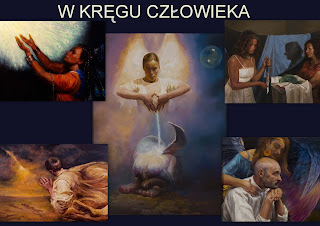
It's great to hear that, because when looking at your artwork, one can feel your passion for painting and the heart you put into it. Nothing feels forced there...
It is certainly as you say, because if there was no passion and this obstinacy, I would be very boring in life, and that's how I stick with myself, with my own work and I'm fine with it.
If there was another incarnation where a choice could be made, I would like to be an artist, but maybe this time in the West, in the US, or maybe in Russia or China? To make it more interesting, because each country has its own mentality and aesthetic patterns. It could be very interesting, because everything is our heritage, and art belongs to all humanity. It is the homeland of homelands because we belong to the same trunk, only we have different branches.
What do you think about your popularity? Does it value you in any way, or does it bother you?
I was surprised, because I never expected to be a popular person. If someone is interested in art, I naturally embrace it: I paint, create, enjoy interacting with the audience, and love exhibitions. So far, over a hundred thousand people have viewed my aforementioned Lechistan series. Museum curators really appreciate my cycles, so they often commission them.
By exhibiting a few years ago at the State Art Gallery in Sopot (Państwowa Galeria Sztuki) (alongside Zachęta, one of the important national galleries), the paintings were seen by approximately seven thousand people, and I was informed that after fourteen years, it was the first time such crowds came to see an exhibition of a living artist. It turned out that before me, it was accomplished by Mr. Jerzy Duda-Gracz.
I am glad that the audience comes, that they are fascinated by it, and that I can communicate with them, because that's what matters to me. And I think it's important for every artist that there is an audience who wants to attend exhibitions, who will put on their boots, grab an umbrella, and go to them, rather than just giving a thumbs up or down on Facebook. In other words, when people visit exhibitions in person, it's very good.
Every day I review books, and I often encounter the opinion that writers write books they would like to read themselves. To paraphrase those words: do you paint artworks that you would like to see yourself?
In a way, yes, because as I mentioned before, painting is a great adventure. There is an idea that slowly emerges, and I would like to see it come to life. In order to see it, I have to create it. I have my favorite works and also those that are less favored.
Painting is a nice dialogue with one's own talent and personality, and the works can sometimes pleasantly surprise, but sometimes they turn out average.
I don't really think about my work, because I'm a bit of a conquistador type - I like to sail around the field of art and discover the field of my own possibilities. Sometimes it ends really badly, and sometimes something cool happens and then I'm happy.
I would not be able - as some colleagues do - to paint one motif all the time. It's incomprehensible to me. My insides couldn't take it. I need to feel the inner movement and agitation, because - as I have already mentioned - painting is a great adventure and a great pleasure for me, where my task is to give the paintings certain painterly values and create the world in terms of composition. So I paint what I feel like and what contains a painting problem that I like to solve each time. Sometimes a painting is created only for a batch of certain textures that I want to get under the pretext of a painting problem. It also happens that it is created because of the subject, and the mentioned things appear only during the work. Either way, it's the same stick, only from two different ends I'm aiming for the effect.
Godo Pan ślónskom godkom, after all, he lived for many years in Chorzów, Silesia? Can we find traces of this in the paintings?
Not really. I don't speak the local dialect (laughter). I came to Silesia when I was eight years old, as a Gorol. It turned out that my father had Silesian roots, so you could say he is a Krojcok, which means a Krzyżak. They used to say: "Are you going to the court?" The court is where the nobility lives, we're going to the square.
I remember Silesia and these wonderful people with sentiment, but I don't talk - sometimes I love to listen, because I hurt myself, having no talent for languages at all. If I stayed there every day, I would remember a lot of things and I would pick up the accent again, because after all, I was a body transplanted to those areas.
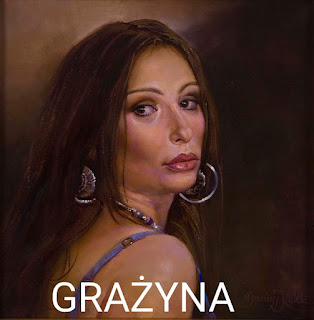
A few portraits were titled "Grażyna." Is she an important woman to you?
Yes, she is my wife, well, she is an important woman to me (laughs). When I sometimes paint women from memory or paint them in, Grazka always comes out. Anyway, my previous wife was also a pretty brunette, so my friends say that I have this characteristic, Caletan type of women's beauty that I like, and I guess it is.
On your paintings, there are also ladies to whom the words of Mickiewicz: "Woman! fleeting fluff! you ethereal being!" do not fit at all, because they are strong, dominant, and even demonic individuals - goddesses, even! Is it to inspire men to action?
Perhaps so. I grew up with mythology, and as you know, strong women are present there: Hera, Athena, Diana, even Niobe, who faced such a tragic fate, but she was a strong woman who managed to bear the weight of that entire tragedy.
I also delved into Homer and Sienkiewicz, while exploring the paintings of Matejko and Siemiradzki, so I have a fondness for the time of heroes. I enjoy painting and giving characters such features. My colleagues claim that because I have dabbled in portraiture, I am a portraitist. However, I consider myself a physiognomist like Malczewski or Matejko, who portrayed tense muscles while simultaneously infusing the subject with internal heroism. If the model lacks specific features, I bestow them upon them. On the other hand, true portraitists were Henryk Rodakowski or Kazimierz Pochwalski. They portrayed the inner self of the model in a relatively objective manner. I admire, for example, Damian Lechoszest, who is an excellent portraitist. Those like him must strive to maintain objectivity and distance while also infusing warmth into the portrayed person.

Did you count how many important women he portrayed in the world, and would history be the same without them?
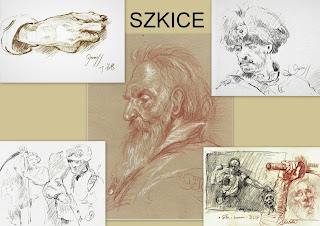
During my studies, I sustained myself through portraiture. It was during the 1980s and 1990s, the time of the Balcerowicz Reforms, when portraits were selling well. I worked as a freelancer, and portraiture became a significant part of my life. I painted, for example, our actress Ewa Ziętek and several other individuals. To this day, there is a portrait of Ochman in my studio, but it's hard to determine how many I have painted. Each time, I sought that internal movement, that profound emotion. Ah, as Rembrandt beautifully expressed it, the movement of the soul.
People - like you - tell me that these people feel and think, which is probably related to the fact that I paint the pictures very loosely - brushstrokes are not "ordered", as in the case of a classic portraitist, because a cloud of thoughts rolls over the forehead of a given person human. I like to feel that someone who looks at the portrait is not entirely sure whether the person in it is completely good or completely evil, and if it is good, there is no justification - it is supposed to result from an inner movement, from this depth ...
Just like we have a left leg and a right leg, I think that time is a measure of which face we show, because a given situation forces you to take a certain attitude, just like in art, which involves making certain decisions. They are what testify to us - those undertaken in life as well as in creativity.
Vincent van Gogh once said: "If you hear a voice within you saying, 'You cannot paint,' then by all means paint, and that voice will be silenced." Do you ever hear such whispers that motivate you to work, or on the contrary, have your successes in the field of painting been enough to keep the brush in your hand continuously for many years?
I highly value the art of Van Gogh, especially his portraits, because they have such a profound expression and message, just like the portraits of Rembrandt. It's about the matter of technique: Rembrandt is perfect, while Van Gogh is very primitive, but the impact and creative power in both of them are tremendous.
And such voices, of course, do arise – whispers like "Give it up now" or "Leave that subject," but I am stubborn and enjoy seeing things through to the end.
There are moments when one needs to give their imagination a rest, and during those times, I take week-long or two-week-long breaks: when I don't paint, I read more, listen to audiobooks, but only when a problem arises and I allow my subconscious to work on it. However, if one keeps painting constantly, there comes a point of exhaustion. I catch myself saying, "God, something isn't right, I can't get this anatomy. What's happening?" That's when I know I'm overworked and need to rest, so that later, all the pieces can fall into place as they should. One cannot always be with family; sometimes one needs to spend time with friends, and then returning to family is even more beautiful.
Does the increased pace of today's life affect the pace of created works, which after all require precision and time? How many hours a day do you spend painting and is the pandemic period conducive to regularity, especially when you are an artist aware of limiting exhibitions and contact with people? Is it harder to get motivated in such circumstances?
Yes, the pace is relentless, which is why I'm eagerly awaiting retirement, hoping to live long enough for it. I would love to "paint myself" at last, but for now, I have to dive into paintings because, apart from being the director of the Gallery in Kołobrzeg on behalf of the Regional Cultural Center, I still need time for my own creativity. For forty years, I've been striving to recapture the techniques of the old masters or at least their understanding, which helps me paint efficiently. However, there are paintings that don't sell, and I spend more time on them. For example, Gorgona took two and a half months to break my old, hindering painting habits and introduce new values. For now, I'm like a travel agency, like Orbis on a group tour, seeing this and that. But there are also subjects I set aside for later, looking forward to playing with them, spending six months to a year on a particular painting. However, that remains a matter for the future.
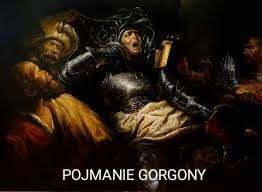
In the pages of Matejko's secretary's memoirs, Marian Gorzkowski, who was also his biographer, I read that apart from his immense talent and genius, Jan was a very busy man, supporting his four children and his wife, who suffered from diabetes. She was given morphine, which caused her to fall into states of dementia, indifference, and lack of empathy. Only when she wasn't under the influence of morphine, she was Jan's former "Tośka." This deeply affected Matejko, and this range of emotions did not make it easier for him to run the School of Drawing in Krakow. Gorzkowski noted that Jan regularly entered his studio, trying to paint for two to four hours, to accomplish something. I also apply this work style. I try to paint for one to three hours a day if circumstances allow, or even just drop by for a moment to make a plan and let the surface dry until I close myself off to paint for eight to twelve hours, finishing everything. In my youth, I worked from eight to sixteen hours, but it didn't make sense because then I was exhausted and couldn't paint for three to four days. Now, however, age catches up with me, and I don't have as much strength as before. Nevertheless, I appreciate the routine because it allows me to live calmly and focus on painting, concentrating on artistic and thematic issues.
During the lockdown, my colleagues had an advantage because people were confined - we were also locked down here at work - so I was able to draw and compose, finding time for reflection. I must admit that it was quite a nice time for me as well. It was easier for me in a way because I have a government position in a municipal gallery, but access to the market was restricted because the internet alone is not enough. That's why I admire them because despite the serious problems associated with the lack of exhibitions, they managed to come out with style while maintaining a great sense of humor.
You do not hide that you draw your knowledge from the school of Jan Matejko and without a doubt you learned a lot from him by looking at the paintings. However, if the time machine allowed you to meet him, would you dare to ask the master something that, in your opinion, would allow you to improve your craft even more?
I would even declare to Master Jan that I could be his slave as long as he taught me.

Are you waiting for creative inspiration, or does it not matter and you paint regardless of whether it appears or not?
I'll be honest with you, I don't believe in such things. There are ideas and the right time for their realization. I like creating cycles because they don't limit me and prevent me from being pigeonholed. I have created: In the Circle of Man, Sarmatia, Lechistan, and now maybe I will start a new cycle. In the meantime, other symbolic works appear, but it is precisely the cycles that allow me to go wild and break certain conventions or look at them with a fresh eye. For example, Gorgon is a particularly special painting for me because I wanted to convey that evil cannot be defeated, as where there is a strong light, there must also be a strong shadow. However, it can be restrained, captured for a certain time, but it will break free from its restraints again, revealing its cruel face. Because as long as there is good, evil will also continue to exist.
I try to paint regularly. If I have no idea for a series, or if I have some downtime, I do exercises posing a technological problem, or I paint heads while practicing psychology on them, I do a study of hands, or I paint a still life for fun, to which I will gladly come back someday... I like being a busy man.
Do you have any habits without which you cannot work? What helps you concentrate?
O Jesus, Lady, I have very bad habits. I like to smoke when I paint because it helps me. I used to listen to electronic music in addition, and now I create in silence because I like to hear my own thoughts, which is probably related to age.
You discovered that you can paradoxically hear more in silence, right?
Yes, silence says a lot, because we allow our own flashes of intuition and subconsciousness to speak. Today I know that silence is as beautiful as simplicity.
Does this silence lead the hand?
Yes, it does. For me, there is now a deeper relationship between the plane of the image, the hand and the brain, it's kind of clearer, but some colleagues listen to audiobooks while painting, which I like to listen to before going to sleep when my eyesight is tired, but I definitely prefer silence that speaks in contrast to the world that only seethes and buzzes.
You are writing in golden letters on the pages of history, while at the same time painting history. Why did you choose her as your guide?
Certainly, due to my great love for painting, such as: Matejko, Rembrandt, Rubens, Van Dyck, Siemiradzki, because history allowed them to carry out beautiful painterly contests – painting metals, glass, people experiencing something, as it was known that there was no cinema at that time, so paintings fulfilled that role. The audience, while observing them, also experienced them. For example, through The Torches of Nero, they experienced the full drama depicted in it.
I was shaped in a heroic spirit also thanks to literature. Sometimes I think it would be nice to paint something calm, but will it work? I don't know, will have to try sometime. Time will reveal the face of tomorrow.
By depicting the past, the Lord creates the future, and thus combines these opposing directions. Difficult and at the same time very interesting action…
In Lechistan - because that's what we're talking about - I drew inspiration from Germanic, Celtic, and Tolkien mythology. Just as Homer created a new dimension of the Olympian gods, Tolkien did the same, and this new dimension is most perceived by the current generation of people in their twenties and thirties. Therefore, I argue - observing the gaps in the knowledge of young people - that while ancient mythology is timeless, it is being replaced by this new mythology. Hollywood contributes to this through movies, computer games, and digital graphics, so ancient heroes now take on the faces of Fantasy - quite different from how they were perceived in antiquity. It's a pity because the ancient world had a great sense of mystery. Behind the gods, there lay not only the physical form but also vast concepts, condensed thoughts, and symbols with a wide range of meanings. Today, we perceive them differently.
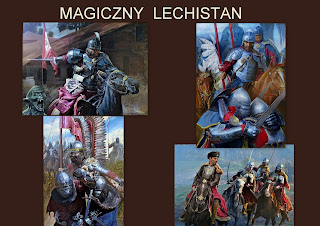
Well, time flies by changing our view on various areas of life, including art, and - in my opinion - on the one hand, it's beautiful, because it adds value to them, but on the other hand, it takes a lot away from tradition. Do you also have similar feelings?
Yes, I have similar feelings, and honestly, Lechistan was partially created to attract the younger generation to history through a continent filled with orcs, harpies, and genetically peculiar creatures. They enjoy watching it, so perhaps they will later reach for Radosław Sikora's book on the Winged Hussars, maybe they will explore our history, maybe they will read Sienkiewicz. However, my intention was to carry the tradition into the future by implanting new iconographic concepts. I searched the internet for information on whether someone in Europe or the United States has done something similar, but only isolated works appear there. Only in China is there a person - I don't remember his name now - who, based on Chinese tradition and mythology, has done something similar to what I did.
The main character of your paintings is a rider on a horse. What - so to speak - captivated you? Was the choice dictated by the fascination with historical works and materializes under the brush due to the seen illustrations and read literature, or is it rather based on your imagination?
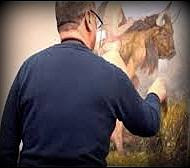
The horse has always been considered a noble animal, especially here in our country. When I was a primary school student, the history of Poland was illustrated with black and white images of our masters: Kossak, Matejko, Brandt, and others. I remember that my friends and I loved looking at them, although we struggled with the knowledge we had to absorb. The illustrations were magnificent, and today I regretfully observe how Mieszko I is depicted on a coin instead of Matejko's representation, where Mieszko is strong and exudes that half-pagan, highly intelligent man who, based on a very logical assessment of the situation, accepts baptism. But on the coin? Crudely minted with a piece of a castle. So how can a young person nourish their imagination with that?
When painting, I rely on reconstruction groups, and I don't care if the horse has thirty-three or thirteen teeth - it's supposed to work, and the world is supposed to draw you in. I also like to sometimes use - as in the Baroque - certain deformations. However, they testify to a conscious struggle of expression, not a lack of painting skills. If you stylize well to enhance the character's expression, then - in quotation marks - it is read as a stylization, not a drawing error.
Fantasy painting also requires knowledge of human and horse anatomy, or any other animal for that matter. I have to observe closely, touch the fur, feel its scent, softness, discover whether steel is soft or porous.
Let's pay attention to the fact that Sapkowski, like Tolkien, created our Polish mythology by bringing the Witcher to life, who has conquered the world not only in computer games but also in books. His cycle about Silesia is also magnificent. The publication of each Witcher book happened to coincide with the time when I was painting My Sarmatia – such an accelerating cycle. When I look at it today with a forgiving smile on my lips, I have the impression that they are rather sketches because that's how an oil sketch looks like for me now. But at that moment, I was returning to creative, inventive art, and that satisfied me.
Undoubtedly, Sapkowski has influenced my artistic subconscious, as well as the late American fantasy writer, David Gemmell, who, although not writing as hefty volumes as the Americans, had the ability to brilliantly depict landscapes, atmosphere, air humidity, and dread in just three sentences, which only a few can achieve. And today, I have discovered the beauty and power of comics, which my son has infected me with. I am impressed by the works of the illustrator Jim Lee, the creator of Batman, which resemble my sketches. It's a wonderful thing! It turns out that a team of people is responsible for this comic, including inking, graphics, and coloring. That's why I buy individual issues, leaving out the ones with compositions that interest me, surprisingly derived from the border of the Baroque style. Transferring them to the realm of painting would be a fairy tale! I enjoy watching talented artists who draw suggestively and create magnificent graphics and compositions. For now, I am experimenting with my painting, introducing dynamic and surprising compositions, dragons, and the like. We will see what the result will be.

Just preparing for the interview, I was surprised to discover that you do not shun the world of Fantasy - which I value very much in literature. So it was a pleasure for me to see that your paintings host fantastic animals, dragons and monsters, creating an unreal atmosphere, tempting with their multicoloredness. It would seem true historyczna i baśń w parze iść nie mogą, a jednak…? Czy to w pewnym sensie ukłon w stronę kolegi po pędzlu, Jacka Malczewskiego?
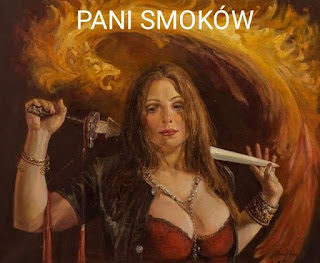
Yes, Matejki, Malczewski... As a child, I remember when I first saw Jacek Malczewski's Farewell to the Studio at the Silesian Museum, I was surprised that someone painted like Matejko because at that time, he was the world's master painter for me and Piotr Naliwajka. Today, I include Malczewski in my top four favorite painters, alongside Matejko, Rubens, and Rembrandt – and the coolest part is that they are all under the zodiac sign of Cancer, just like me. That's why I always joke that I'm in distinguished company: Matejko was born on June 24, I was born on June 25, Rubens on June 28, and Malczewski and Rembrandt were born on July 14 and 15, respectively.
When someone asks: what will I regret most when I die, I answer that not my family or this world, but the fact that I will not be able to stand in awe in front of the paintings of my beloved Masters. I will surely regret this when I close my eyes and say goodbye to this hell.
Let's go back to historical paintings, because my attention was also drawn to the draperies and robes in which the Lord dresses the characters. Do you sketch them using available sources, or do they arise for some other reason?
When I finished the series Within the Circle of Man, I had a dialogue with myself: "Think, Kaleta, what do you enjoy painting?" "Well, I enjoy painting fur, steel, people who experience something, movement..." "If that's the case, then recreate Sarmatia in a different version." And that's how Lechistan was born.
Have you considered adding an inspiring narrative to the paintings included in the thematic collections Magic Lechistan or My Sarmatia, which could have a chance to reach schools and intrigue students with history as a subject that deals with ancient figures and events, yet remains relevant and alive?
My colleague - who has quite a good pen - suggested writing a book called Magic Lechistan, where alongside the hussars and gromoviti, there could be spells and enchantments. It would probably be a fantasy novel in which our heroes would be entangled.
At one time I did a few things that Paweł Huelle was kind enough to praise for my writing style - but it was necessary to decide: I will either play writer or I will play painter. You can also play Renaissance man, but I don't consider myself to be such, so I stayed with painting.
It is not a coincidence that I am asking this question, because looking back to my school or high school days, I find that not much is said about the times of Lechic, or even the topic is passed over in silence...
Our historians do not like this topic, but the writer and researcher Janusz Bieszk - author of the book Slavic Kings of Lechia. Ancient Poland - reveals the sources. Sometimes, without prejudices and complexes towards others, we need to look at our own history. Considering the name, one should be proud of this heritage. By no means should it be associated with megalomania. It's just about being faithful to the facts and delving into history. However, modern textbooks do not allow young people to discover who we really are.
Is there a chance that one day you will paint a series of artworks titled, for example, Trylogiada? I'm thinking here of portraits of characters taken from the pages of Sienkiewicz's novels, as the material for creative endeavors is undoubtedly enormous...
I'll be honest, I highly doubt it, as such remarkable artists have already illustrated his novels that I wouldn't dare to. On the other hand, I won't rule it out completely, because who knows, a crazy idea like Mój Lechistan might pop into my head again? In that case, a Mój Sienkiewicz could emerge in a completely different light, presenting the author in a new way. However, it doesn't change the fact that I certainly wouldn't dare to compete with the magnificent tradition of 19th-century illustration.
I hope that thanks to Lechistan, young people will be inspired to read Sienkiewicz. I read his works when I was in the third grade of elementary school, so I grew up with Sienkiewicz, Mickiewicz, and Słowacki, whom I highly appreciate for their language and words, just as I do with Wyspiański.
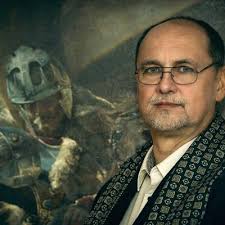
Among all the paintings painted so far, is there one that you could not sell for any treasures in the world?
Yes, there are paintings that I can't sell because they belong to my closest ones.
I cannot deny that having reached the age of sixty-one, I will be aging. Lechistan is still being sought after, but I do not sell it, knowing that it will be exhibited for several more years. It serves as my security for old age because if someone appreciates it, they might think, "Oh! Kaleta is still alive. Perhaps I'll commission something from him?" And when I am no longer able to paint, Lechistan will serve as a reminder that I used to paint. I sympathize with my colleagues who sell everything and then, in old age, lack the strength and have nothing. Therefore, it is worth making conscious decisions each time because money is not everything. I do not succumb to the cult of owning objects that I could purchase, which allows me to live a simpler and better life. I form my opinion of a person by asking them what they are interested in, rather than basing it on what they possess. I appreciate the simple life I lead, as long as I can paint peacefully.

The audience can see your paintings, exhibited both in Poland and abroad: in Germany, the USA, France… In which other countries would you like to present yourself and for what reason?
As for France, I have only exhibited older works there, but I would present myself wherever there was a desire to see, regardless of the country.
Space travel has recently become fashionable. If you had the desire and the opportunity to go there, which painting would you take with you and why?
I'd rather time travel than space travel, it would be much more interesting. Would I take anything? Probably not, rather relatives: son, daughter, wife ... Maybe a small head? I'd rather look at new things than not at things I've already brought to life.
If it were possible, I would travel like an astral body - with consciousness. It would be great to see what Mieszko I, Bolesław Chrobry looked like, or what the scene of the murder of Leszek the White in Gąsawa or the charge at Kircholm looked like. It would be an interesting experience to be able to hang as a cloud of energy over these characters without disturbing or interfering with them watching what it was like. It would be great fun for me! Maybe thanks to such a possibility, humanity would reach a higher spiritual level?
I often wish writers to break their pen, and what could I wish you? Brush breaks?
Do you know what? The endless pleasure of painting.
In that case, I wish you the best.
In a final word to the readers, I would like to say one more thing…
I am very pleased that, thanks to you, I can meet you - once or twice - turn on your thinking, because it gives you sensitivity.
ABOUT! And that's the perfect conclusion to our conversation, I think…and I'm very grateful for it and for your time.
I also thank you for the interview, for the kind words that encouraged me to continue creating. There are still people who like this type of painting ... I bow beautifully and above all I wish you a lot of health, because it is the most important.
Dariusz Kaleta had a conversation with Iwona Niezgoda, the creator and organizer of the independent "Book of the Year" contest in Poland, called Brakująca Litera. Iwona Niezgoda also runs the blog Góralka Czyta.
Editor in Chief: Barbara Demuth-Garbień
Reportage: Iwona Niezgoda
